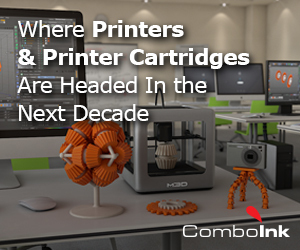Where Printers & Printer Cartridges Are Headed In the Next Decade
The inkjet printer was invented back in 1976. Yet, it took another 12 years before it actually became a consumer item that you and I could buy and use in our homes and offices. Fun fact, did you know in 1988 the inkjet printer cost $1,000? Since those early days, we have seen a print revolution! Now, almost every home and office now has their own printer(s).
We use our printers to perform many tasks. Our photos and documents can be scanned, copied and printed. Even from multiple devices, and sometimes, even wirelessly. You can now buy a printer in well under $100. So printing has come a very long way in the past couple of decades. Do you wonder what the future holds?
Digital Printing Right Now
Digital printing has overtaken traditional printing methods such as lithography. It now holds about half of the total market share in printing and is expect to grow. Digital printing is enabling marketers to communicate easily with customers. It’s even helping governments easily create and implement policies.
Quick Response (QR) Codes, or printed machine readable squares, have replaced traditional bar-coding in several areas. This is because of better storage capacity. As well as applications that include time tracking, product tracking, general marketing and document management.
Ink Cartridges of the Future
In the printer cartridge market, it is well known fact that cartridges manufactured by OEMs (original equipment manufacturers) are quite pricy. Especially in comparison to generic products which are able to offer the same quality and print volume. Another trend is that while OEM cartridges appear to be getting more expensive, the price of generics appears to remain low. with newer technological advancements driving prices of generics even lower. Our comparative chart demonstrates (insert link or table as image here) how much less generics cost today.
Small wonder then, that OEMs are either going to court! As well as trying out innovative marketing gambits (including smear campaigns) to constantly reign in generic product sales.
The Impression Products v. Lexmark suit is a case in point. Here Lexmark has sued 40 to 50 companies as well as customers in a toner cartridge remanufacturing dispute. The outcome of this litigation, which pivots on the First Sale Doctrine, is likely to have far-reaching implications for the printer cartridge market.
OEMs are also trying to stay competitive by developing new products such as the newly announced EcoTank printers announced by Epson. Assuming that one household printer prints about 200 pages per month, the ‘ink tank’ (as opposed to traditional cartridges) would last for about 2 years. In fact the company also offers a 1 year guarantee along with an assurance of 30,000 printed pages. One key change we see here is that printers are priced high (about $400). The company looks to make its profit from the printer rather than repeated cartridge replacements. This is a significant departure from the normal way OEMs make their profit.
The Seemingly Endless Possibilities of 3D Printing
The future of printing is quickly moving towards 3D printing! Imagine creating personalized objects, buildings, food and perhaps human tissue with the help of these printers.
These 3D printers use various plastics and other items to create brand new objects layer by layer. Makers and inventors, designers and medical professionals alike are constantly finding new ways to use these printers for good. Often, these new inventions cost a fraction of the cost of traditional manufacturing processes.
Some examples of 3D printing : a house, car, artificial ear, and even a printed prosthetic.Already, industrial 3D printers are able to make auto and airline parts.
The type of 3D printer you and I can use today at home helps us to create 3 dimensional objects, gifts, toys, décor and display items that we can actually use. We can ‘print’ personalized chocolate and waffles to suit our tastes and perhaps create a working firearm as well. Then there is the rise of 3D printing in pharmaceuticals.One example is that 3D printing can make pills into specific shapes and sizes for sustained or rapid release.
Clearly the printing industry is on the cusp of new and exciting things. Watch this space for more news!

